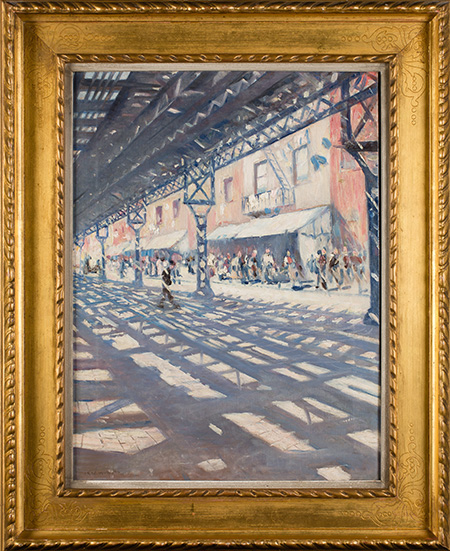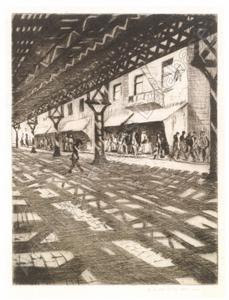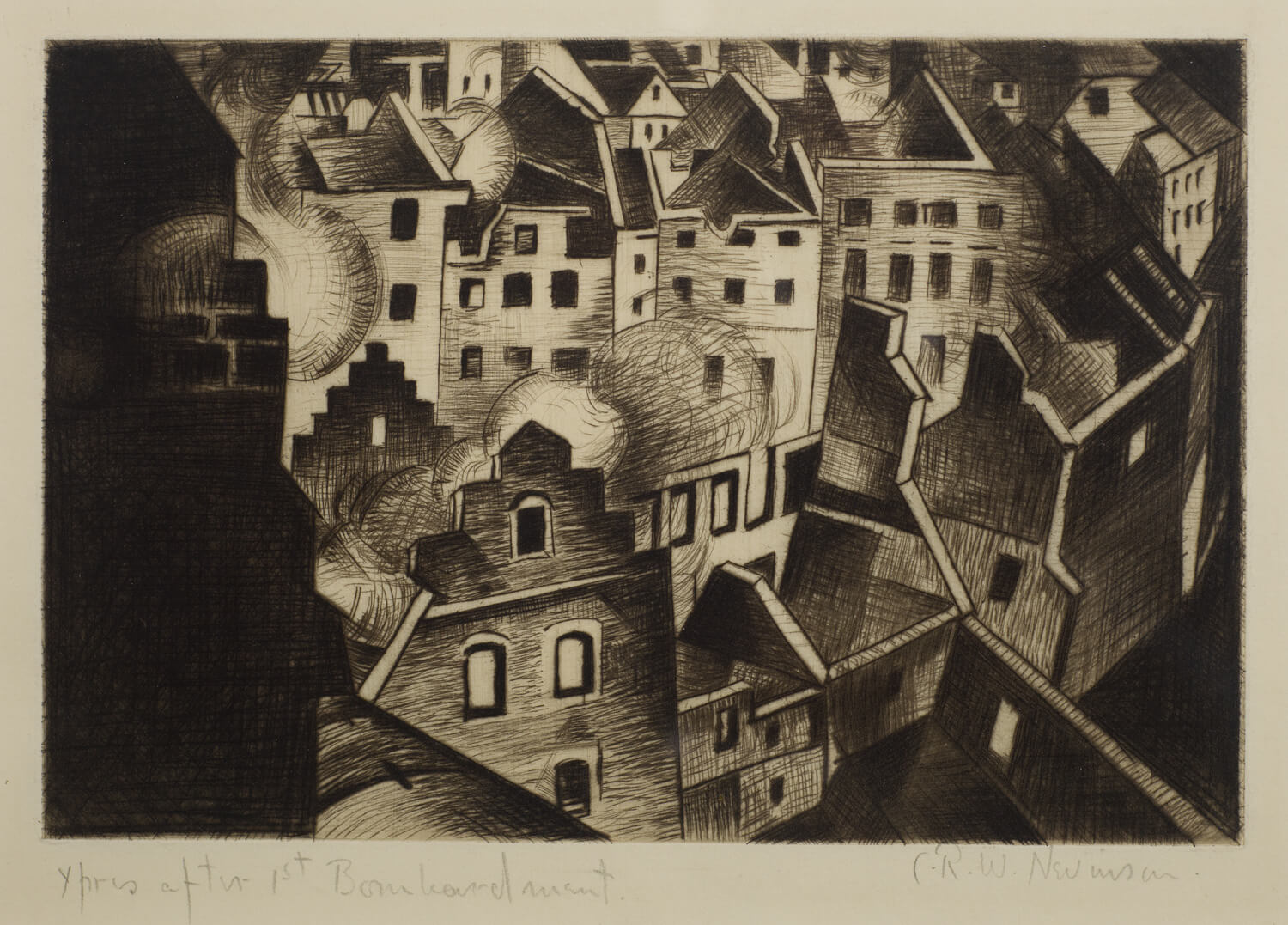Exhibited : New York, Bourgeois Gallery, The Old World and the New, Nov-Dec 1920, where purchased by C. B. Cochran. Cambridge, Kettles Yard, C.R.W. Nevinson: A Retrospective Exhibition, Sep-Oct 1988 London, Imperial War Museum, C.R.W Nevinson, The Twentieth Century, October 1999-,January 2000, No. 86 (colour plate, p.142).

Following the popular success of his two exhibitions of First World War paintings and drawings at the Leicester Galleries in 1916 and March 1918, Nevinson made two trips to New York, the first in 1919 and again the following year. His first visit was to attend the exhibition of his etchings and lithographs at Keppel & Co with a catalogue introduction by the well known critic and connoisseur Albert Gallatin. A larger exhibition of ninety four works – paintings, etchings, lithographs and woodcuts – was held the following year (10 November – 4 December) at the Bourgeois Gallery, where this work was first exhibited. Nevinson and his wife had sailed for New York in September, so this evocative view of the Old El’ must have been painted soon after their arrival. Unlike a number of his works, which were carefully and somewhat self-consciously, created as studio compositions, such as Tate Britain’s Soul of the Soulless City, Third Avenue, Elevated Railway captures the immediacy and excitement of the scene with its bustle and noise. One senses that it was set down enthusiastically directly in front of the subject, with every brushstroke capturing the mood of dappled sunshine and shadows as well as the multiplicity of colourful figures on the sidewalk beyond.
This contrast between √° la prima and studio works is commented on by Chloe Johnson in her essay The Soul of the Soulless City, (op. cit pp. 10-11): Third Avenue, Elevated Railway shows a specific site, with colourful shadows under the rail track and picturesque pedestrians. More akin to the paintings of the Ashcan School and the work of early twentieth century British artists such as Walter Sickert and the Camden Town Group, this image is a fleeting glimpse of a moment of modern urban life.’ Jonathan Black (op.cit. p. 77) notes its stylistic links to the works of both Robert Henri and John Sloan, whom Nevinson had met on his previous visit to New York.
The Third Avenue Elevated Railway – the El – built in the 1870s, ran from Chatham Square in the City Hall area of Manhattan to Gun Hill and White Plains in the Bronx until it was gradually demolished, section by section, over a twenty-three year period from 1950. Jack Finney in his 1970 time-warp novel, Time and Again, vividly summons up memories of the incongruous clatter’ if you were on the street below, as trains thundered overhead, as well as recalling images of its old stations. He described these in detail with their bare worn floorboards, wooden tongue-and-groove walls, and little scooped-out shelves projecting from under the change-booth window, grained and polished from ten thousand hands.’ Today, with its cavernous streets and anonymous high- rise buildings, such images of a vanished New York increasingly evoke a strong feeling of nostalgia.

An etching, titled ‘Under the Elevated’, issued in an edition of 75, was included in the 1921 New York series of dry points by Nevinson.

We are grateful to Dr. Jonathan Black for the following chronology (May 2014):
Christopher Richard Wynne Nevinson: Chronology:
13 August 1889: born John Street (now Keats Grove), Hampstead to Henry Woodd Nevinson (1856-1941) and Margaret Nevinson n e Jones (1858-1932).
1901: Nevinson family moved to 4 Downside Crescent, Belsize Park, London. This remained Nevinson’s home until 1919.
September 1903-December 1907: educated Uppingham Public School, Rutland.
February 1907: visited exhibition of etchings in London by Muirhead Bone and James Abbott McNeil Whistler.
1908: art student at St. John’s Wood School of Art, Elm Tree Road, London.
1909-1912: art student at the Slade School of Art, University College, Gower Street, London.
May 1909: visited exhibition of etchings in London by Francis Dodd.
May 1911: visited Professor Michael Sadler to see his collection of German Expressionist woodcuts.
1911-1912: received instruction in lithography from Ernest Jackson, London County Council School, Southampton Row, London.
April 1913: first meeting with a Futurist artist ‘ Gino Severini.
October 1913: exhibited Futurist paintings at the âPost-Impressionists and Futurists’ exhibition, Dor Galleries, New Bond Street, London.
November 1913: founder member of the London Group.
June 1914: publication in London of the English Futurist Manifesto (with F.T. Marinetti) âVital English Art.’
November 1914-January 1915: service as an ambulance driver and medical orderly with the Friends Ambulance Unit in France and Belgium.
June 1915-January 1916: service as a private in the Royal Army Medical Corps at the Third London General Hospital (Territorial), Wandsworth.
June 1915: exhibited as an âIndependent’ in the Vorticist Exhibition, Dor Galleries, London.
November 1915: married Kathleen Mary Knowlman at Hampstead Town Hall.
Summer 1916: made first prints (drypoints).
26 September-4 November 1916: first solo exhibition held at the Leicester Galleries, Leicester Square, London (included 12 prints ‘ all drypoints).
January 1917: first lithographs exhibited at Senefelder Club, Leicester Galleries, London.
June 1917: contributed six lithographs on theme of âMaking Aircraft’ to Britain’s Efforts and Ideals lithographic series commissioned by the Department of Information.
July-August 1917: one month in France and Belgium as an official war artist for the Department of Information.
January-February 1918: made first woodcuts.
1 March-5 April 1918: exhibition of his official war art held at the Leicester Galleries, London (included 19 prints: 11 lithographs; 6 drypoints and 2 woodcuts).
Summer 1918: made first mezzotints.
January 1919: renounced adherence to Futurism.
29 April-17 May 1919: exhibition of 46 prints at the Frederick J. Keppel Galleries, 4 East 39th Street, New York (21 lithographs; 20 drypoints; 3 mezzotints and 2 woodcuts).
May 1919: first visit to New York.
June 1919: death of only son Anthony Christopher Wynne Nevinson in London.
June 1919: moved to Flat 1, 295 Euston Road, London.
October 1919: solo exhibition at the Leicester Galleries, London (included 10 prints: 4 mezzotints; 3 lithographs; 2 drypoints and 1 woodcut).
July-August 1920: solo exhibition at the Manchester City Art Gallery (included 26 prints: 15 lithographs; 8 drypoints and 3 mezzotints).
October-November 1920: Nevinson and wife visited New York.
8 November-4 December 1920: solo exhibition âThe Old World and The New’ at the Bourgeois Galleries, Fifth Avenue and 53rd Street, New York (included 31prints: 18 lithographs; 11 drypoints and 2 mezzotints).
April 1921: 10 New York prints exhibited at Friday Club, London.
July 1921: 12 New York prints exhibited at the Keppel Galleries, New York.
August 1921: moved to Number One, Steele’s Studios, Haverstock Hill, London.
February 1922: made first etchings and aquatints.
February 1923: solo exhibition of 47 drypoints and etchings at the Leicester Galleries, London.
April 1924: 20 of his prints displayed inside the British Pavilion at the 19th Venice Biennale.
January 1926: exhibited 40 drypoints and etchings with Walter Sickert in exhibition âTwo British Etchers’ at the Albert Roulier Galleries, South Michigan Avenue, Chicago, USA.
October 1926: solo exhibition of prints at the Kraushaar Galleries, Fifth Avenue, New York.
January 1927: solo exhibition of prints at Alex Reid and Lefevre Gallery, Glasgow.
January 1927: elected a member of the Savage Club, London.
25 April-21 May 1927: solo exhibition of 56 prints at Alex Reid and Lefevre Gallery, Cork Street, London (26 drypoints; 22 etchings; 4 etchings with aquatint and 4 mezzotints).
July-August 1927: solo exhibition of prints at the Ruskin Galleries, Birmingham.
May 1929: elected a member of the New English Art Club, London.
January 1930: elected Vice-Chairman of the National Society.
October 1930: solo exhibition at the Leicester Galleries, London (included 38 prints: 16 etchings; 11 drypoints; 9 lithographs and 2 mezzotints ‘ this would be his last major public display of prints).
April 1931: joint exhibition with sculptor Barney Seale at J. Leger & Son Gallery, Fifth Avenue, New York.
November 1931: 6 of his prints included in the British Art Exhibition, Tokyo, Japan.
1932-1933: prolonged period of serious illness; nearly died in summer of 1932.
February 1932: elected a member of the Royal Society of British Artists.
May 1932: publication of a volume of Modern Masters of Etching: C.R.W. Nevinson by Malcom Salaman.
June 1932: death of Margaret Nevinson.
October 1934: published Exodus AD: A Warning to Civilians with Princess Princess Troubetzkoy (Muriel Beddam).
November 1937: published autobiography Paint and Prejudice.
May 1938: appointed a Chevalier of the Legion d’Honneur by the French Government.
April 1939: elected an Associate of the Royal Academy, London (proposed by etchers Francis Dodd and Henry Rushbury).
September 1940: volunteered to work as medical orderly and stretcher bearer at the Royal Free Hospital, Hampstead.
November 1940: suffered a mild stroke while tending wounded at the Royal Free Hospital.
1941-1942: unofficial war artist attached to RAF Bomber Command.
November 1941: death of Henry Nevinson.
October 1942: suffered second more serious stroke, lost use of right hand and lost sight in right eye.
7 October 1946: died at home, no 1 Steele’s Studios, Chalk Farm.
May-June 1947: C.R.W. Nevinson Memorial Exhibition held at the Leicester Galleries, London.
10 September-30 October 1988: C.R.W. Nevinson: A Retrospective Exhibition, Kettle’s Yard Gallery, University of Cambridge.
28 October 1999-30 January 2000: Retrospective Exhibition C.R.W. Nevinson: The Twentieth Century, Imperial War Museum, London.
25 September-25 October 2014: Retrospective Exhibition of his prints C.R.W. Nevinson: A Printmaker in War and Peace, Osborne Samuel Gallery, London.